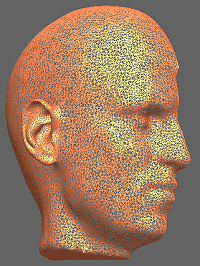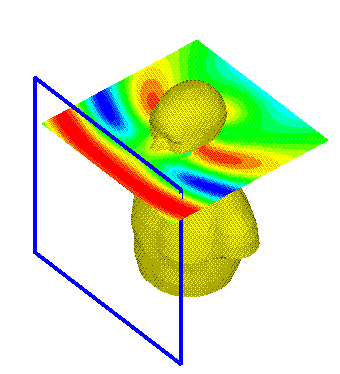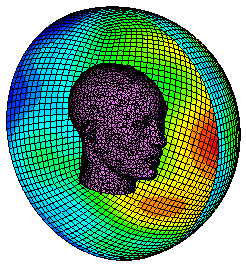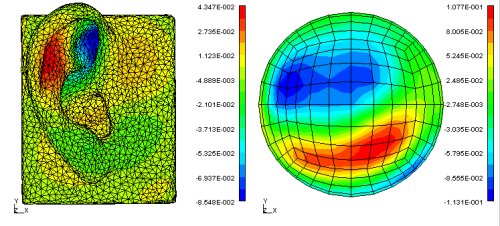|
| |
Numerical Modelling (1997-2001)
|
Introduction
Most
current spatial sound reproduction systems are based on the concept of
the binaural technology. These systems are referred to in the literature
as ‘3D audio’ (Begault, 1994), virtual auditory display (Wenzel et al,
1993), virtual auditory space (Carlile, 1996), virtual acoustic imaging
(Nelson et al, 1997), and similar variations. The goal of the system designer
is to ensure that the reproduced signals in the ears of a listener, through
either headphones or loudspeakers, are equivalent to those detected under
real listening conditions. In order to manipulate the signals arriving
in the eardrum of the listener in a binaural synthesis process, it is required
to know the directional characteristics of the physically filtered signals,
encoded in the Head-Related Transfer Function.
It should be noted that there are
other approaches to produce spatial sound, which are not based on the HRTF.
For example, ‘wave filed synthesis’ (Berkhout et al, 1993) reconstructs
the propagating waves in a restricted area using the exact Helmholtz-Kirchoff
equation, or ‘loudspeakers-walls’ system (Ono et al, 1998) which recreates
an approximation of a desired impulse response of a room. Both methods
require large number of loudspeakers.
In recent years the number of scientific
papers, products and applications associated with the HRTF has grown rapidly
due to two main reasons (1) the advances in computing power and the possibilities
to implement digital filters with low-cost DSP chips, and (2) advances
in research on the physical, physiological, and psychoacoustical aspects
of spatial hearing and the interaction between them.
|
 |
|

One of the main limitations of the
binaural technology is the generalisation of the HRTF of a particular listener
or an artificial head for the entire population. When individualised HRTFs are
used (i.e. either the recording is done with microphones positioned in the ears
of the listener, or monophonic signals are synthesised with the listener’s HRTF)
and we assume no errors are introduced in any part of the reproduction chain
(transducers, acoustic medium, head movements, etc…) we may not need to deal
with the complexity of the perception of sound by the auditory system. In
practice, errors are inevitable, and exact reproduction cannot be achieved.
Therefore, psychoacoustical studies must be carried out in order to investigate
the physical cues encoded in the HRTF and the perceptual importance of these in
the auditory system.
It appears in many psychoacoustical studies published in the
last 50 years that the task of localisation of sound is more complex than
assumed originally in Lord Rayleigh’s duplex theory (Rayleigh, 1907). Although
the significance of the external ear is now well recognised as a complex
acoustical antenna, it is still not understood how the different cues are
combined in the auditory system, and from the neurophysiological view if all the
information detected by the pinna can be encoded by the nervous system.
High fidelity HRTFs are currently required by both the research
community and the designers of virtual auditory displays. Traditionally, these
databases are acquired by measurements. The procedure of measuring HRTFs is very
time consuming, and expensive. These are currently limited to well-equipped
acoustic laboratories only, and as a result, most HRTFs are either confidential
or restricted to research purposes. There are also many problems encountered
when these functions are measured, analysed and compared between different
studies. For example it is difficult to define the point at which the microphone
should be positioned in the ear canal, the type of transducers used,
equalisation techniques, dealing with signal to noise ratio problems, etc. In
addition, HRTFs are generally measured only at discrete points with a low
directional resolution. As a result, any real-time virtual auditory display
would need to make use of interpolated functions.
|
|
In this study, we suggest
an alternative approach to acquire individualised HRTFs, by using computer simulation techniques rather than measurements.
The conversion of imagery data into its acoustical response should be achieved,
in principle, by solving the wave equation. The idea is not new, as this
was stated by Weinrich (1984) who first investigated the response of the
human head (without pinnae) using numerical techniques:
"The rather complicated geometric
shape of the pinna makes a rigorous mathematical treatment very difficult
– perhaps impossible"
And recently also by Shinn-Cunningham
and Kulkarni (1996):
“Theoretically, it is possible to
specify the pressure at the eardrum for a source from any location simply
by solving the wave equation…. Needless to say, this is analytically and
computationally an intractable problem”
In this research, we attempt to
investigate the feasibility of obtaining accurate HRTFs using computer
simulation, and to develop a tool that can be used to investigate the acoustical
characteristics of the external ear. |
 |
|
|

The focal point of this work is
to investigate whether it is viable to predict high frequency components
in the frequency response of the external ear using simulation tools. The
targets and questions asked throughout the research are given below:
-
Investigate the feasibility of using
various numerical techniques to investigate HRTFs at low to medium frequencies
using simple models. Can we simulate the response of these simple models
so that these can be used, for example, in a structural model, such as
the one proposed by Genuit (1986, 1987)?
-
Simulate HRTF of accurate geometry
models. Can we validate the results with measurements carried out in an
anechoic chamber?
-
Develop a tool to investigate the acoustical
characteristics of the human ear. Can we reduce our problem by substitution
of the head with an infinite baffle, and concentrate on the contribution
alone, independently of the other parts of the human body?
-
Identify common characteristics of
the external ear by visualising the response at high spatial resolution
at different azimuthal and elevation planes. By simulating and measuring
a few pinnae under exactly the same controlled conditions, continuous maps
of the variation of peaks and notches in the frequency response can be
obtained. Are these results comparable with those found in the literature?
-
Investigate the frequency response
of the external ear that can be used mathematically to reconstruct individualised
HRTFs. In the area of HRTF modelling, low-order parametric functions are
required mainly for the implementation of real time virtual auditory displays.
Can we find, using simulation tools, common physical patterns that can
be used for this purpose?
-
Validate the normal mode shapes measured
by E.A.G Shaw and published over a period of three decades. To the author's
best knowledge, his work summarising the mode shapes of the pinna has not
yet been validated nor continued. Can we obtain the same patterns with
our simulated pinnae models?
-
Visualise sound fields of virtual acoustic
imaging systems using loudspeakers. The equalisation zone ('sweet spot')
is primarily affected by the loudspeaker arrangement. Can we predict the
sound field around the head, while designing an ideal cross-talk cancellation
network with the individualised HRTFs modelled in the first step?
|
|
Up |

